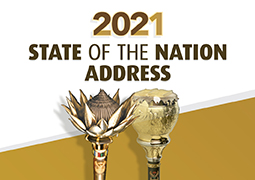
Serjeant-at-Arms and Usher of the Black Rod
The Serjeant-at-Arms and the Usher of the black rod are responsible for compliance with security policy in and around the Chamber and galleries, and implement related instructions from the Speaker of the National Assembly (NA), the Chairperson of the the National Council of Provinces (NCOP) and other Presiding Officers. They also perform ceremonial functions, such as leading the procession into the Chamber at the start of proceedings.
They lead the President and the Presiding Officers to their seats and proceed to place the mace and the black rod in place before the Speaker and the Chairperson, respectively.
When the decorum of the House, which is maintained by upholding the rules of the House or joint sitting by Members of the House, is threatened or compromised by a Member of Parliament, the Presiding Officer orders the Member or Members to “leave the House” and calls the serjeant-at-arms in the NA or the usher of the black rod in the NCOP with the assistance of the protection services police officers to force the Member or Members of the House to leave the House if they don’t comply with the order of the Presiding Officer.
The South African Parliament is the site of democracy and right from its inception in 1994 it was opened to embody all the tenets of democracy. Due to the evolution of that open nature of democracy, robust engagement on issues within the House has become one of its primary features. Sometimes the heat of debate becomes too much for the rules and eventually the decorum of the House is compromised. To restore order, a Member or Members who compromise it are ordered to leave the House.
Mace and Black Rod
The mace is a symbol of authority of the Speaker of the NA. When the serjeant-at-arms carries the mace into the debating chamber and places it before the Speaker, it means that the NA is formally in session and that its proceedings are official.
The mace was designed to reflect the history, traditions, and diverse cultures and languages of South Africa. The design also celebrates the country’s natural beauty, its plant and animal life and its rich mineral resources. The shape of the mace recalls the knobkerrie, an African symbol of defence as well as authority and leadership. Gold symbolises not only our country’s natural wealth, but also the indigenous knowledge of Africa and the ancient African gold mining traditions of Mapungubwe.
The black rod is the symbol of the authority of the Chairperson of the NCOP. It reflects the important role of the provinces in the functioning of the NCOP. When the usher of the black rod carries it into the debating Chamber, and places it before the Chairperson of the NCOP, it means that the NCOP is formally in session and that its proceedings are official.
The black rod is also in the form of a knobkerrie. The protea at the head of the black rod is South Africa’s national flower and symbolises national pride. The beadwork reflects on South Africa’s diverse people and its rich cultural heritage. The clasping hands in gold symbolises freedom, peace and cooperation.
The black rod stands in a drum when the council is in session. The drum is an expression of the African tradition of drums calling people to gather and speak. It is also symbolic of our achievement of democracy through dialogue.

